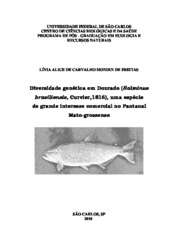| dc.contributor.author | Freitas, Lívia Alice de Carvalho Mondin de | |
| dc.date.accessioned | 2016-06-02T19:29:28Z | |
| dc.date.available | 2010-08-31 | |
| dc.date.available | 2016-06-02T19:29:28Z | |
| dc.date.issued | 2010-06-18 | |
| dc.identifier.citation | FREITAS, Lívia Alice de Carvalho Mondin de. Diversidade genética em Dourado (Salminus brasiliensis Curvier,1816), uma espécie de grande interesse comercial
no Pantanal Mato-grossense. 2010. 131 f. Tese (Doutorado em Ciências Biológicas) - Universidade Federal de São Carlos, São Carlos, 2010. | por |
| dc.identifier.uri | https://repositorio.ufscar.br/handle/ufscar/1690 | |
| dc.description.abstract | Salminus brasiliensis is a migratory fish which is distributed in all parts of the rio de la Plata Basin. The Dourado is called the king of the river . It´s one of the most sought after fish by amateur and/or professional fishermen. However, in some regions it is considered to be a vulnerable species. Recent reports have shown the existence of some populations of migratory fish that are genetically structured in the same basin. Considering that the evaluation of variability and genetic structure in natural populations is of great importance for conservation of this species, this study has the objective of examining this question in the populations of S. brasilienses in the region of the Pantanal in Mato Grosso by verifying the existence or not of the genetic structure by means of markers of mitochondrial DNA. Later a phylogeographic approach was carried out to investigate the aspect of genetic evolution of this group of fish, its distribution in all the basin and its relation with the history of the formation of the basins- the relation between the Pantanal, the Parana and Uruguay Rivers Basins. The results shown high genetic diversity and absence of genetic structure, suggesting gene flow between populations of north and south of the Pantanal, probably facilitated by the migratory ability of the species and by the structural characteristics of the region. The presence of shared rare haplotypes evidences this pattern even though exclusive variants occur in each river studied. In relation to the phylogeographic aspects of the group in the limits of the basin of the Rio de la Plata, an old historical contact was verified between the sub-basin of the Parana and Upper Paraguay Rivers, probably occurring at the moment of the formation of the Pantanal. However, analyses has disclosed a current genetic distance between the populations of Dourado in these two areas. Genetic structure was only observed in the Parana River Basin. The Uruguay River Basin and the Pantanal demonstrate genetic similarity. However, it is important to continue evaluation and monitoring of genetic diversity of the natural populations of Dourado to confirm if with other molecular markers if the same pattern will occur as the on in the Pantanal and in the other regions that have been analyzed. | eng |
| dc.format | application/pdf | por |
| dc.language | por | por |
| dc.publisher | Universidade Federal de São Carlos | por |
| dc.rights | Acesso Aberto | por |
| dc.subject | Conservação | por |
| dc.subject | Dourado (Peixe) | por |
| dc.subject | DNA mitocondrial | por |
| dc.subject | Diversidade genética | por |
| dc.subject | Filogeografia | por |
| dc.subject | Bacia Platina | por |
| dc.subject | DNAmt | por |
| dc.subject | Dourado | eng |
| dc.subject | DNAmt | eng |
| dc.subject | Genetic diversity | eng |
| dc.subject | Phylogeography | eng |
| dc.subject | Platina Basin | eng |
| dc.title | Diversidade genética em Dourado (Salminus brasiliensis Curvier,1816), uma espécie de grande interesse comercial
no Pantanal Mato-grossense | por |
| dc.type | Tese | por |
| dc.contributor.advisor1 | Galetti Júnior, Pedro Manoel | |
| dc.contributor.advisor1Lattes | http://genos.cnpq.br:12010/dwlattes/owa/prc_imp_cv_int?f_cod=K4783603A4 | por |
| dc.description.resumo | Salminus brasiliensis é um peixe migrador distribuído em toda bacia do Prata. Denominado rei do rio , o dourado está entre os mais almejados na pesca esportiva e/ou profissional. Porém, em algumas regiões está sendo considerada uma espécie vulnerável. Relatos recentes demonstraram a existência de algumas populações de peixes migradores geneticamente estruturadas dentro de uma mesma bacia. Considerando que a avaliação da variabilidade e estrutura genética em populações naturais é de grande importância para conservação dessa espécie, este estudo objetivou primeiramente abordar esta questão em populações de S. brasilienses na região do Pantanal Mato-grossense, verificando a existência de estruturação ou não nessa região, por meio de marcadores de DNA mitocondrial. Depois foi realizada uma abordagem filogeográfica para discutir aspectos referentes à genética evolutiva desse grupo de peixes, sua distribuição por toda bacia e sua relação com a história de formação das bacias; uma relação entre o pantanal e a bacia do Paraná e do Uruguai. Os resultados mostraram alta diversidade genética e ausência de estruturação, sugerindo fluxo gênico entre populações das localidades norte e sul do Pantanal, provavelmente facilitada pela habilidade migratória da espécie e pelas características ecológicas da região. A presença de haplótipos raros compartilhados evidencia esse padrão, embora variantes exclusivos ocorram em cada rio estudado. Quanto aos aspectos filogeográficos do grupo nas limitações da bacia do rio da Prata, foi verificado um contato histórico antigo entre a sub-bacia do Paraná e o Alto Paraguai, provavelmente ocorrido no momento da formação do Pantanal. No entanto, análises revelaram um distanciamento genético atual entre as populações de dourado nessas duas áreas. Estruturação genética só foi observada para o Paraná, sendo que Uruguai e Pantanal demonstraram similaridade genética. Entretanto, é importante continuar a avaliação e o monitoramento da diversidade genética das populações naturais do dourado para confirmar se com outros marcadores moleculares ocorrerá o mesmo padrão ora encontrado no Pantanal e nas demais regiões analisadas. | por |
| dc.publisher.country | BR | por |
| dc.publisher.initials | UFSCar | por |
| dc.publisher.program | Programa de Pós-Graduação em Ecologia e Recursos Naturais - PPGERN | por |
| dc.subject.cnpq | CIENCIAS BIOLOGICAS::ECOLOGIA | por |
